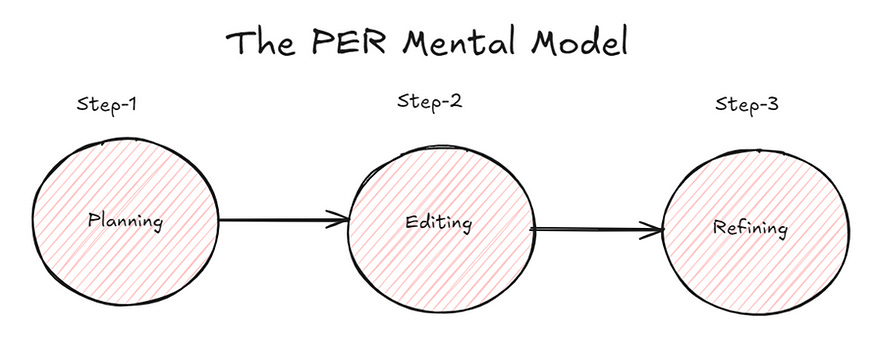Happy Saturday, champ 💖
“Mental set-up” is the one thing that can make or break your life.
Not only your life, but also your:
success
relations
happiness
health
All these things (in one way or another) get shaped by how you think and perceive. In fact, your writing is also influenced by the quality of your mental state.
If you have a sound mental state, it reflects in your writing. If it’s the opposite, that shows too. So, we can conclude that these two things have a direct connection.
Now, the question is:
How will you develop the correct mental set-up to ensure that your writing becomes more efficient and relatable to your readers?
The answer is by using ‘mental models’.
In simple terms:
Mental models are shortcuts that allow you to approach problems, make decisions, and organize your work more effectively.
Learning these models can be a game-changer for anyone, because I’ve seen the results personally, especially with my writing.
So, what are those mental models that will enhance your writing skills?
Let’s unfold them one by one.
1. CAS (Collect And Store)
Tell me one thing, what’s your biggest strength as a writer?
It’s — Ideas.
Right?
Ideas are undoubtedly the backbone of excellent writing, and they don’t always come when you’re sitting down to write.
They cross your mind at random intervals. Maybe when you’re:
taking a shower
moving in a car
or, resting in the loo
As a human, you cannot remember every idea that comes to your mind. (Read that twice!)
It’s because your brain is made for generating ideas, not for holding them.
So, you need to use the CAS model.
This model focuses on storing and collecting ideas you may otherwise forget.
How to use it?
Set a daily goal to write down at least one idea, no matter how small. To find them, you can read blogs, books, or consume content from creators who genuinely provide value. Once you’ve got the idea, store it.
You can use Notion, the Notes app on your phone, Evernote, or even a notebook to do so. I use Notion and a notebook.
Next, create categories for your ideas (e.g., personal, social media, etc.) to stay organized.
Note: If you create content for multiple social platforms, you can make a separate doc for specific platforms. I use the same method.
Revisit your idea collection when you feel stuck; it’s an instant cure for writer’s block!
2. PER (Plan, Edit, Refine)
This model breaks the writing process into three main stages:
Planning
Editing
Refining

In the planning stage, you outline your main ideas and the overall structure of your piece.
Pro Tip: Use the Idea File that you’ve created by using the CAS Model.
This doesn’t have to be detailed; even a rough sketch can help. Simply choose one topic and start writing without worrying about making it perfect.
Next, jump to editing.
Editing is where you flesh out your initial draft, checking any grammatical errors, language flow, etc.
Finally, in the refining stage, you polish your work.
You add any missing details and make sure everything makes sense. Here’s a trick I use at this stage: I read the text out loud. By doing that, I can catch sentences, words, or transitions that are adding friction to the flow.
And then I fix them.
If you don’t want to read it yourself, use a tool like Speechify (a text-to-speech reader).
Remember: Each writing stage serves a purpose. Don’t skip them!
3. OPOS (One Problem, One Solution)
I personally love this model!
It’s pretty simple:
Focus on one problem at a time and offer one clear solution.
When you’re writing, it’s tempting to tackle a lot of issues at once. But this can confuse your readers. They might get lost in all the information and miss your main point.
Let’s say you’re writing about ‘productivity’.
Instead of covering everything from time management to workspace organization, pick one specific problem.
It could be:
How to Stop Procrastinating as a Writer
Or
3 Ways to Boost Your Productivity as a Writer
Whatever the heading is, make sure you’re dealing with one problem at a time.
How to Use it?
Before you start writing, clearly state the one problem you’re addressing.
If you catch yourself drifting to other issues, stop and refocus.
Ask a friend, sibling, or someone you trust to read your work and see if they can easily identify the problem and solution. (I tell my brother to review my articles. It gives me another perspective, and he can spot any areas where I might have drifted off-topic or made things unclear.)
You can find your own reading buddy!
That’s all for today.
Apply these mental models to your writing and notice the difference they make.
See you next Saturday:)
Sweta
If you found value in this edition, tap the 💖 button below or pass it along to someone who might enjoy it. Also, share your thoughts in the comments. I read all of them:)








This is a valuable post. Thank you so much. I have used CAS Model and saved this post for future reference.
Top-notch content.